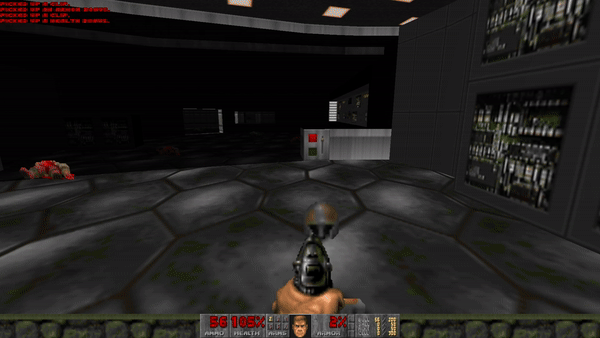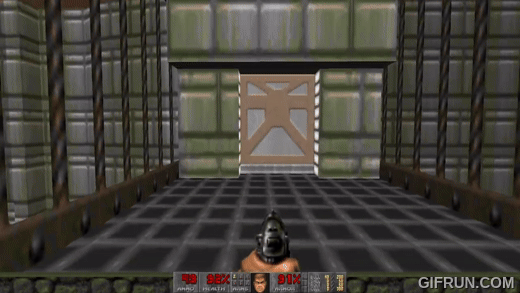Brandon Badger
Game Designer
Reimagining Doom's First Level
Overview
This level is meant to reimagine a tutorial level of Doom using the popular source port, GZDoom, and Ultimate Doom Builder as the level editor. GZDoom is a widely-used port for the 90’s Doom games as it has strong modding capability and a dedicated modding base. GZDoom also adds features like free look and jumping that were not present in the original Doom in 1993. While GZDoom is capable of much beyond what Doom has from a technical perspective, I wanted to remain faithful to the original game’s limitations to create as much of a vanilla Doom experience as possible.
I chose to work on Doom because I thought it would be fun to return to the roots of the first-person shooter genre. I also thought that Doom’s pseudo-3D limitation was an interesting constraint for me to think through when designing levels. Additionally, creating a tutorial is a strong constraint specifically for Doom itself. Doom is at its strongest when running through levels, blasting hordes of enemies. Restraining my toolset to the most basic enemies and making sure to give space for teaching several of Doom’s mechanics is a unique challenge to keep the level interesting.
Process
1. Doom Research
During my playthrough, I kept notes about elements in the game that stood out to me. Among the many notes taken, the ones that I felt the most important to capture from my experience include:
-
Emphasis on fast movement within levels
-
A surprisingly good balance between tense fights and exploration
-
Abundance of secret areas to uncover on repeat playthroughs
-
Emphasis on surprise fights from (often) unpredictable triggers
Overall, I found the game to be much more enjoyable than I anticipated. The feeling of movement and intensity in Doom is unlike anything I have experienced in a first-person shooter before, and I was pleasantly surprised by its emphasis on exploration.
The one negative element that stuck out to me as a player was its unclear and contradictory visual language. Often switches were not immediately readable as to their purpose. Many triggers would change the level or allow passage through sections without my knowledge of what I did to trigger them. For a game with an abundance of secret areas, I think vagueness can be beneficial and promote replayability. However, the degree of this vagueness often left me confused and feeling lost as to how to progress further.
A major goal of my level, beyond capturing and teaching the core features that Doom is famous for, is to make the visual language for interactables as clear as possible to the player, especially given that this level is meant to be a tutorial.
2. Level Design Document
Purpose:
-
Document the overall level goals to identify a direction.
-
Identify and connect key beats or "moments" in the experience.
-
Highlight additional important elements in my particular level (Teachable Moments in this case)

My goal was to try to pace out each of the “teachable moments” so that players have time to focus on each goal individually within a section of the level. I wanted to ensure players had breathing room to take in each feature so that they did not feel overwhelmed while ensuring that the pace felt engaging throughout the progression of the level as a whole.
3. Layout Sketch
Purpose:
-
Think through specifics of the player moving beat to beat.
-
Think about layout to help players orient themselves within the level.
-
Map out points of interest, landmarks, combat encounters, and unique interactions within your level.

I wanted a unique landmark placed in the center of the map (indicated by the 'L' in the picture) to be used as a strong directional marker for players to properly orient themselves within the space. This landmark should be viewable at multiple points within the level so that they can properly identify their progress.
4. Level Block Out
My goal when creating any level is to build the skeleton of it first so that I can play through it from start to finish as quickly as possible. I utilize the skateboard method from product development to level design seen below:

-
In short, the goal is to create a working version of an entire level (or a skateboard) first rather than trying to slowly build the polished level bit by bit (the car).
-
By building the “skateboard” first, you will learn about the overall pacing and flow much more quickly that may drastically change its structure.
5. Playtesting & Iterating
To properly playtest my level, I asked for the help of a few colleagues to stream them playing through it. Through four rounds of their testing, I would take the information gathered from their playthroughs to iterate on the level to represent better the goals I wanted it to deliver. Among the various issues noted throughout my playtests, I'll go through two of the issues that arose:
1) Nobody knew that the door and the switch were connected in the first area.
Solution:

I adjusted the button's position within the room and made the door light up when opened.

Before

Before/After updating the switch height

After
Adjust the button's location and height so that it frames the door within the window in the player's view.

Door that cannot be opened directly

Door that can be opened
Openable doors are indicated by lights and locked doors lack light. I also added an openable door prior to the switch room for players to learn this visual language prior to the locked door.
2) Players wanted more time to utilize the shotgun more in the level

Shotgun was originally placed on the balcony accessible halfway through the final combat encounter.
Solution:

I decided to make a dedicated room that showcases the advantages of the shotgun earlier in the level. Upon picking up the shotgun, enemies appear from surprise doors, allowing them to test out the gun at close range. Not only is it an improvement to the level's overall pacing, but the surprise offers a strong player moment.
6. Postmortem
Overall, I am pleased with how the level turned out! It was quite a unique challenge to try to create a tutorial reimagining for Doom. Looking back at my original Level Design Document for the level, I definitely overscoped the level. My level is far larger than "Hangar" from Doom by several minutes. While I did not focus as much on jumping and free-look as I initially thought, I ended up leaning much further on clearing up visual language for players. It was the biggest source of confusion during my initial playtests and my initial playthrough of Doom. Therefore, I found it to be a much more fulfilling challenge to solve.
I had a lot of fun working in Ultimate Doom Builder to create this level, and I will be making more Doom levels in my spare time going forward!
Walkthrough (with commentary)
(requires a copy of Doom II and GZDoom)